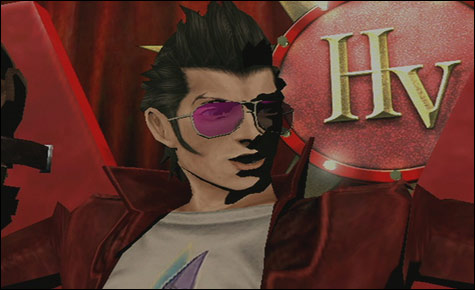
GAME LOVE No More Heroes breathes new life into even the most tired tropes.
|
What’s the last time you played a video game that had the guts to be itself? Not a simulation of something that happens in real life. Not an interactive movie. I’m talking about something that could exist only as a video game.
No More Heroes is the brainchild of the iconoclastic Japanese designer who calls himself Suda 51 and whose first stateside credit was the overlooked GameCube title Killer 7. So often, the effort and the expense of creating a game mandate design by committee. This results in some very good games, but rarely do we get anything visionary. That’s not the case here. Suda 51 seems to approach game design the same way precocious filmmakers do (say, Tarantino in the Pulp Fiction era), taking everything he’s ever liked in a game and mashing it all together till it becomes wholly his own. Playing No More Heroes, you get the impression of Suda 51 grabbing at his influences with the zeal of a kid on the Nickelodeon Super Toy Run.
What’s so great about this game isn’t the way its roots show so much as the ardor with which those roots are embraced. The plot sounds like something you might get from Rockstar Games. The 11th-ranked hitman in the city, Travis Touchdown, is contacted by a mysterious woman and given the task of eliminating the 10 assassins above him. But that ranking system is literal. After Travis dispatches each foe, the player is treated to a high-score screen that wouldn’t look out of place in an arcade circa 1982.
Such committed artifice pervades the gameplay and its setting, the fictional town of Santa Destroy. Want to go to the ATM? Look for the gigantic dollar sign hovering over the sidewalk. The office where you pick up your assassination assignments, why, that’s the one with the pixelated skull outside the front door! Developers have tried to phase out these sorts of unrealistic markers in recent years; Suda 51 reclaims them. No More Heroes is so in love with being a game that it finds a way to breathe new life into even the most tired tropes. Many games make you do side work to earn money. No More Heroes takes this conceit to the extreme, assigning Travis such menial tasks as mowing lawns and pumping gas. But the game doesn’t scoff at these things — it celebrates them.
Consider the combat. Pitting the playable character against waves of almost identical disposable foes is a mechanic as old as games themselves, and yet No More Heroes makes it fun with a sly and effective use of the Wii remote. Wielding his “beam katana,” a wholesale ripoff of the Star Wars light saber, Travis can attack and defend from a high or a low position depending on the position of the remote. It’s a small touch, but it adds some flair to the swordfighting. Travis can also attack his foes with a plethora of pro-wrestling-style suplexes, which themselves are motion activated. They’re reminiscent of the brutal kills in Manhunt 2 — except with a sense of humor, and a reason for existing.
Of course, hacking and slashing through waves of foes wouldn’t be complete without some amped-up artificial gore, and there’s plenty of that to go around. Decapitations and disembowelments are accompanied by geysers of pixelated blood. To make sure you get the point, Suda 51 has the bisected corpses of Travis’s enemies spewing streams of coins toward him with the force of a firehose and the high-pitched jingling of a cash register. Where else but in a video game?